
Is All Oatmeal Gluten-Free?
Whether you are following a strict gluten-free diet due to celiac disease or gluten intolerance or are simply looking to make healthier food choices, you may be wondering whether oatmeal is a safe and gluten-free breakfast option. While oats themselves do not contain gluten, there is confusion about whether all oatmeal products are gluten-free. In this comprehensive guide, we’ll explore the world of gluten-free oatmeal and provide you with all the information you need to safely enjoy this nutritious food.
The Ultimate Guide to Gluten-Free Oatmeal: What You Need to Know
Before we dive into the topic of gluten-free oatmeal, let’s define what we mean by this term. Gluten-free oats are those that have been processed in a way that avoids cross-contamination with gluten-containing grains like wheat, barley, and rye. This can be a challenging task, as oats are often grown and processed alongside these other grains.
If you are looking for gluten-free oats, you have several options available. Look for products that are labeled as “gluten-free” or “certified gluten-free”, as these have been tested and verified to contain less than 20 parts per million of gluten. Some popular brands of gluten-free oats include Bob’s Red Mill, GlutenFreeda, and Bakery on Main.
Oats are a nutritious grain that provides a range of health benefits. They are high in fiber, protein, vitamins, and minerals, and have been shown to help lower cholesterol levels and regulate blood sugar. For these reasons, they make an excellent addition to any diet, including a gluten-free one.
If you are purchasing gluten-free oat products, it is important to be aware of labeling requirements. In the United States, the FDA requires that any product labeled as “gluten-free” must contain less than 20 parts per million of gluten. This means that you can feel confident that products labeled as such are safe for those with celiac disease or gluten intolerance.
How to Safely Enjoy Oatmeal on a Gluten-Free Diet
To safely enjoy oatmeal on a gluten-free diet, there are a few tips you should keep in mind. First, be sure to choose certified gluten-free oats, as mentioned earlier. Next, make sure to prepare and cook your oats in a way that avoids cross-contamination. This means using clean utensils and cookware, and avoiding cooking other gluten-containing foods alongside your oats.
When it comes to toppings and mix-ins for your oatmeal, the good news is that there are plenty of options that are naturally gluten-free. Fresh fruit, nuts, seeds, and dairy products like yogurt and milk can all add flavor and nutrition to your oatmeal without adding gluten.
The Truth About Gluten in Oatmeal: Separating Fact from Fiction
There has been some controversy surrounding the issue of gluten in oatmeal. While oats themselves do not contain gluten, they are often grown and processed alongside wheat, barley, and rye, which can lead to cross-contamination. However, several studies have shown that most people with celiac disease can safely consume gluten-free oats without experiencing any adverse effects.
If you are concerned about consuming gluten through your oatmeal, be sure to choose certified gluten-free products and follow safe preparation and cooking practices.
Gluten-Free Breakfast Ideas: Exploring the World of Oats
Oatmeal is a versatile and delicious breakfast option that can be prepared in a variety of ways. To get you started, here are a few recipe ideas:
- Oatmeal breakfast bowl with fresh fruit and nuts
- Gluten-free oatmeal muffins
- Oat pancakes or waffles
- Simple oatmeal porridge with cinnamon and honey
- Savory oatmeal bowl with roasted vegetables and a poached egg
A Beginner’s Guide to Gluten-Free Oatmeal: Tips and Recipes
If you are new to gluten-free oatmeal, it can be helpful to have some advice and recipe ideas to get you started. Here are a few tips:
- Experiment with different brands and types of gluten-free oats to find the ones you like best
- Try adding nut butter, honey, or maple syrup to your oatmeal for extra flavor
- Make a batch of gluten-free oatmeal bars or bites for an easy snack on the go
Oatmeal and Gluten: Understanding Cross-Contamination Risks
If you are concerned about cross-contamination when it comes to gluten-free oats, you are not alone. This is a common concern among those following a gluten-free diet. To minimize your risk of exposure to gluten, look for products that are labeled as “certified gluten-free”, and choose products that are manufactured in a facility that is dedicated to gluten-free processing.
It is also important to store your gluten-free oats in a clean, dry place away from other gluten-containing grains. This can help prevent accidental cross-contamination in your home kitchen.
Gluten-Free and Delicious: Creative Ways to Use Oatmeal in Your Cooking and Baking
Oatmeal can be a surprisingly versatile ingredient when it comes to cooking and baking. Here are a few ideas:
- Use oat flour as a gluten-free alternative to wheat flour in baking recipes
- Add oatmeal to your smoothies for extra fiber and nutrition
- Make homemade granola bars with gluten-free oats
- Make a savory oatmeal bowl with roasted vegetables and chicken or tofu
Conclusion
In conclusion, oats themselves do not contain gluten, but cross-contamination during processing can be a concern. If you are following a strict gluten-free diet, be sure to choose certified gluten-free oats and follow safe preparation and cooking practices. With so many delicious and nutritious options available, there’s no reason why you can’t enjoy a hearty bowl of gluten-free oatmeal as part of your healthy diet.




